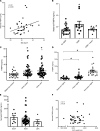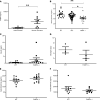The adipokine FABP4 is a key regulator of neonatal glucose homeostasis
- PMID: 34676825
- PMCID: PMC8564897
- DOI: 10.1172/jci.insight.138288
The adipokine FABP4 is a key regulator of neonatal glucose homeostasis
Abstract
During pregnancy, fetal glucose production is suppressed, with rapid activation immediately postpartum. Fatty acid-binding protein 4 (FABP4) was recently demonstrated as a regulator of hepatic glucose production and systemic metabolism in animal models. Here, we studied the role of FABP4 in regulating neonatal glucose hemostasis. Serum samples were collected from pregnant women with normoglycemia or gestational diabetes at term, from the umbilical circulation, and from the newborns within 6 hours of life. The level of FABP4 was higher in the fetal versus maternal circulation, with a further rise in neonates after birth of approximately 3-fold. Neonatal FABP4 inversely correlated with blood glucose, with an approximately 10-fold increase of FABP4 in hypoglycemic neonates. When studied in mice, blood glucose of 12-hour-old WT, Fabp4-/+, and Fabp4-/- littermate mice was 59 ± 13 mg/dL, 50 ± 11 mg/dL, and 43 ± 11 mg/dL, respectively. Similar to our observations in humans, FABP4 levels in WT mouse neonates were approximately 8-fold higher compared with those in adult mice. RNA sequencing of the neonatal liver suggested altered expression of multiple glucagon-regulated pathways in Fabp4-/- mice. Indeed, Fabp4-/- liver glycogen was inappropriately intact, despite a marked hypoglycemia, with rapid restoration of normoglycemia upon injection of recombinant FABP4. Our data suggest an important biological role for the adipokine FABP4 in the orchestrated regulation of postnatal glucose metabolism.
Keywords: Adipose tissue; Endocrinology; Glucose metabolism; Metabolism.
Conflict of interest statement
Figures






References
Publication types
MeSH terms
Substances
Associated data
LinkOut - more resources
Full Text Sources
Medical
Research Materials

